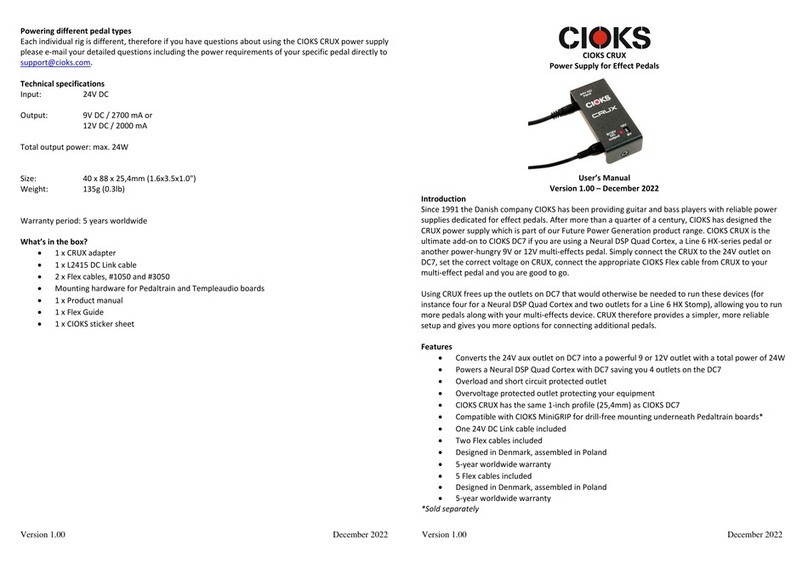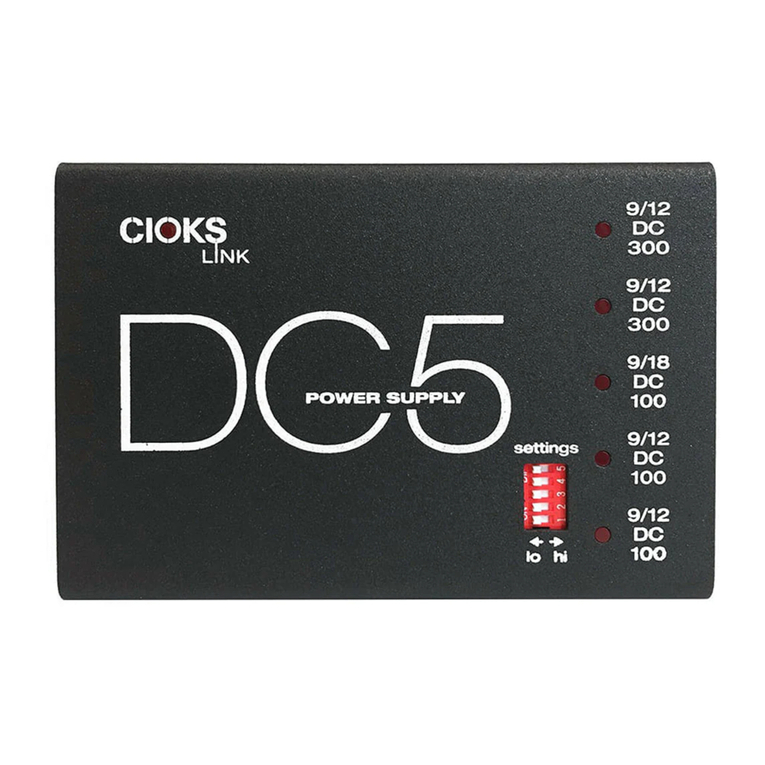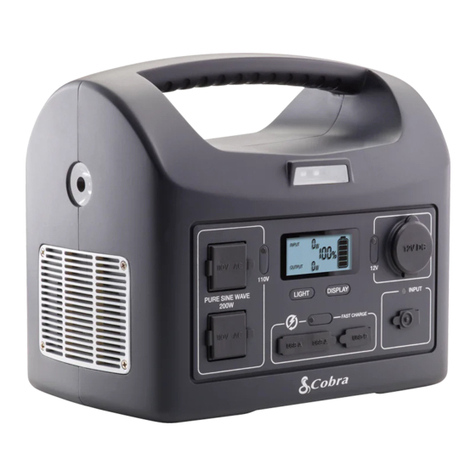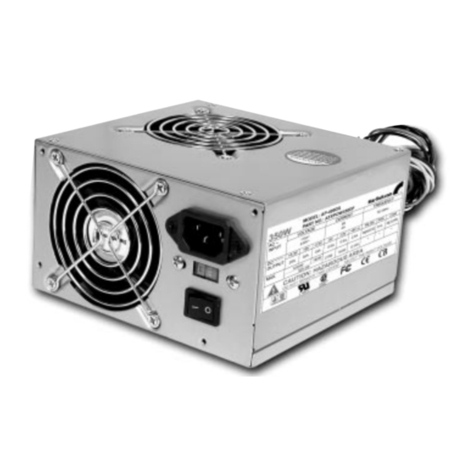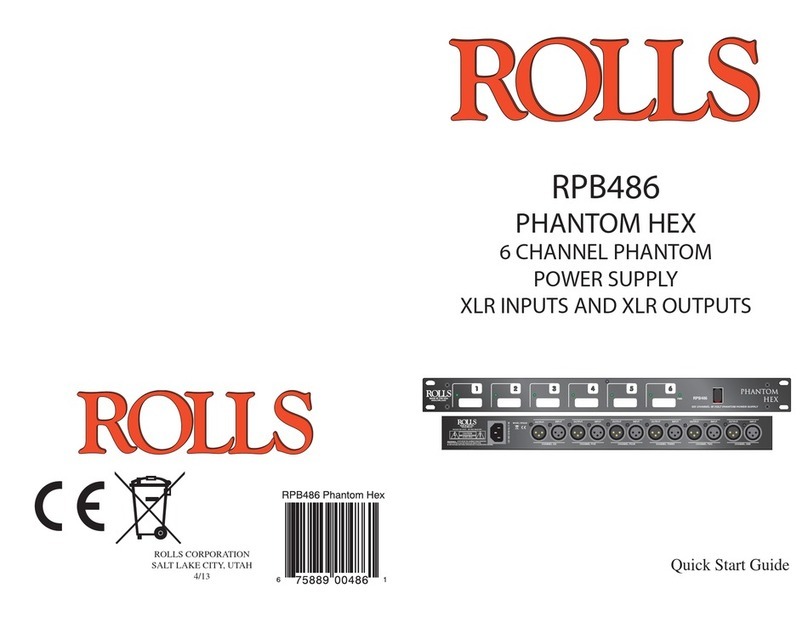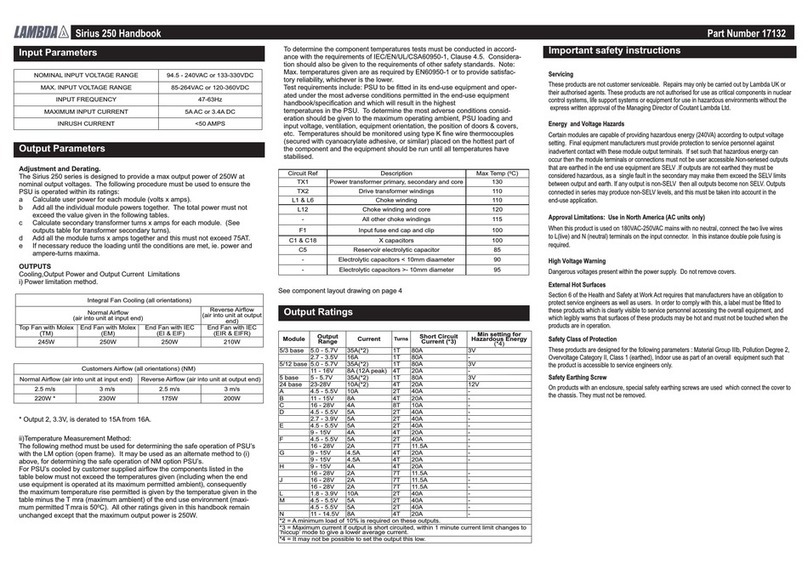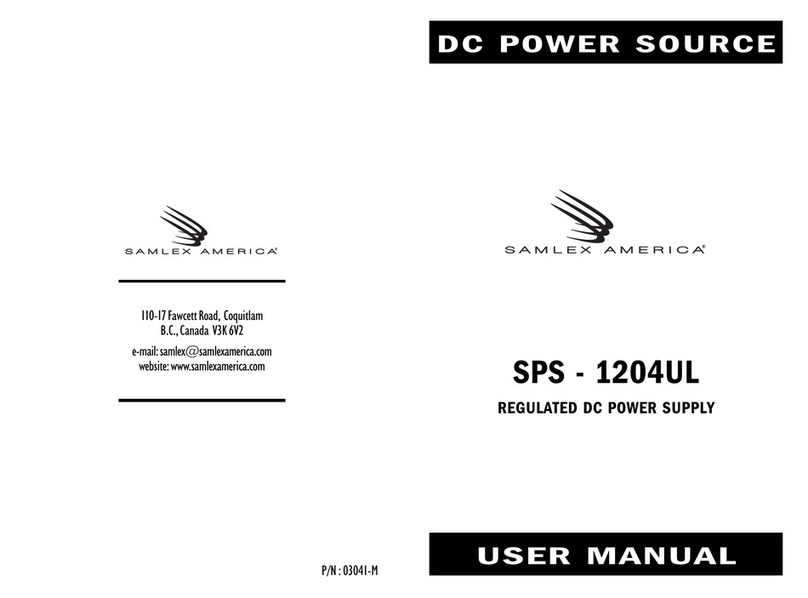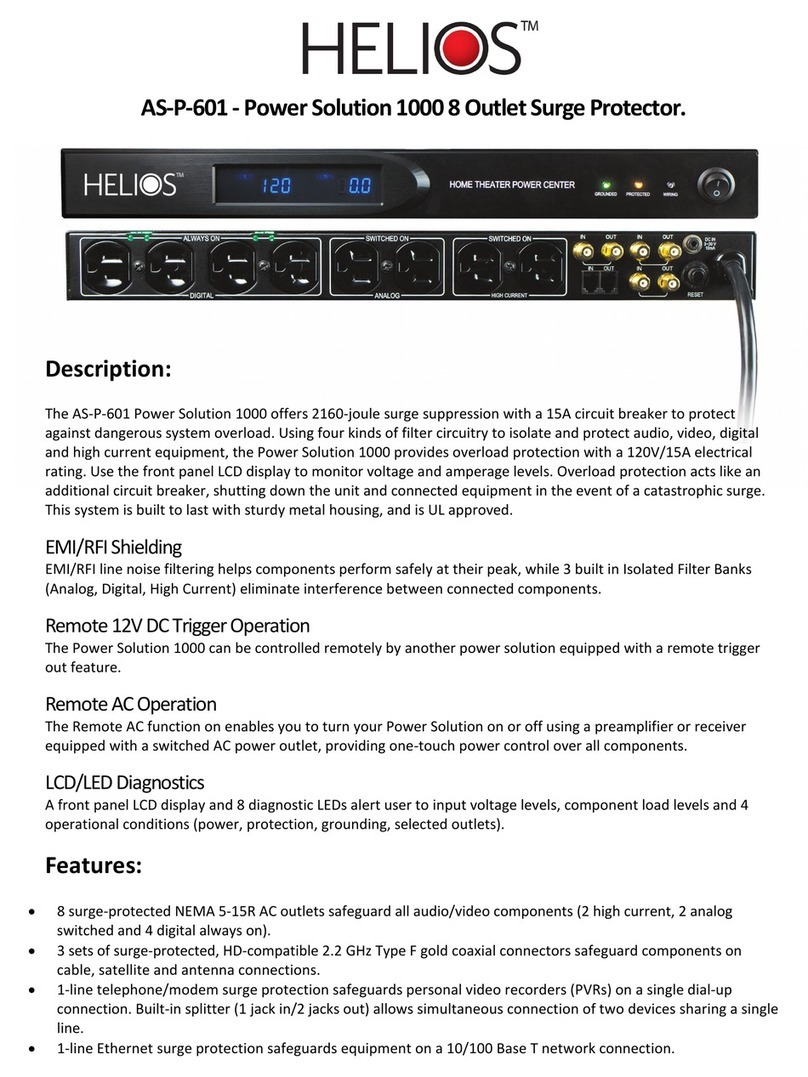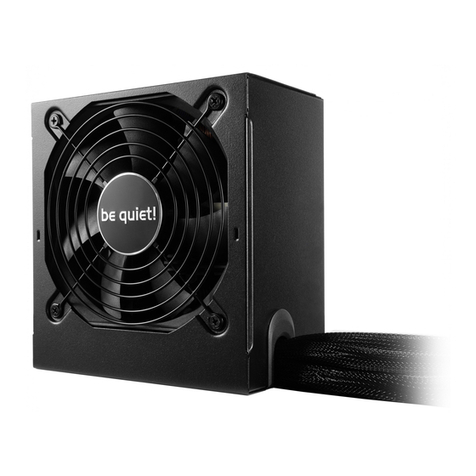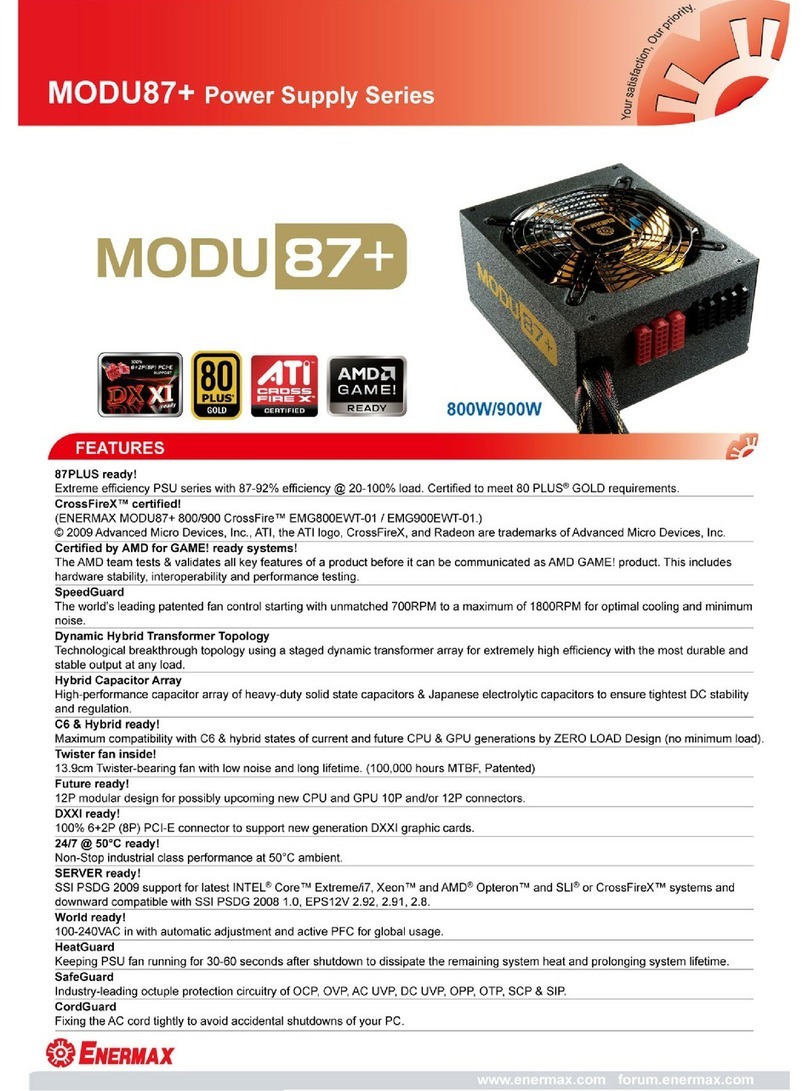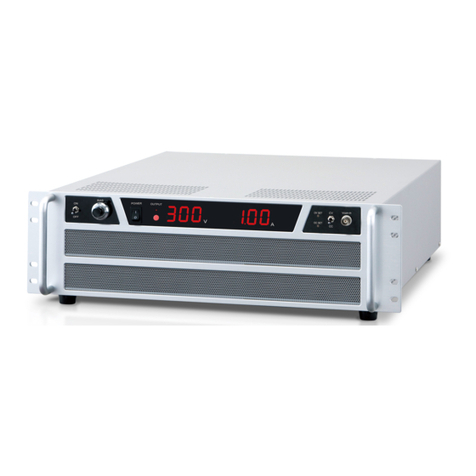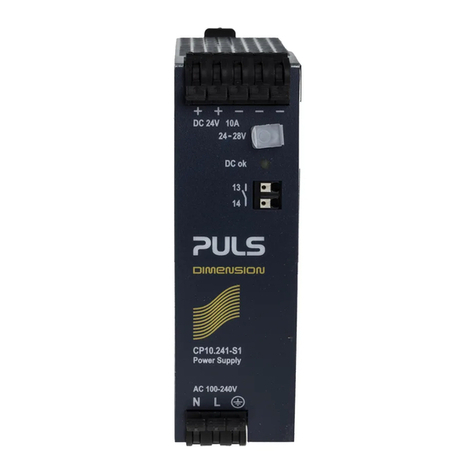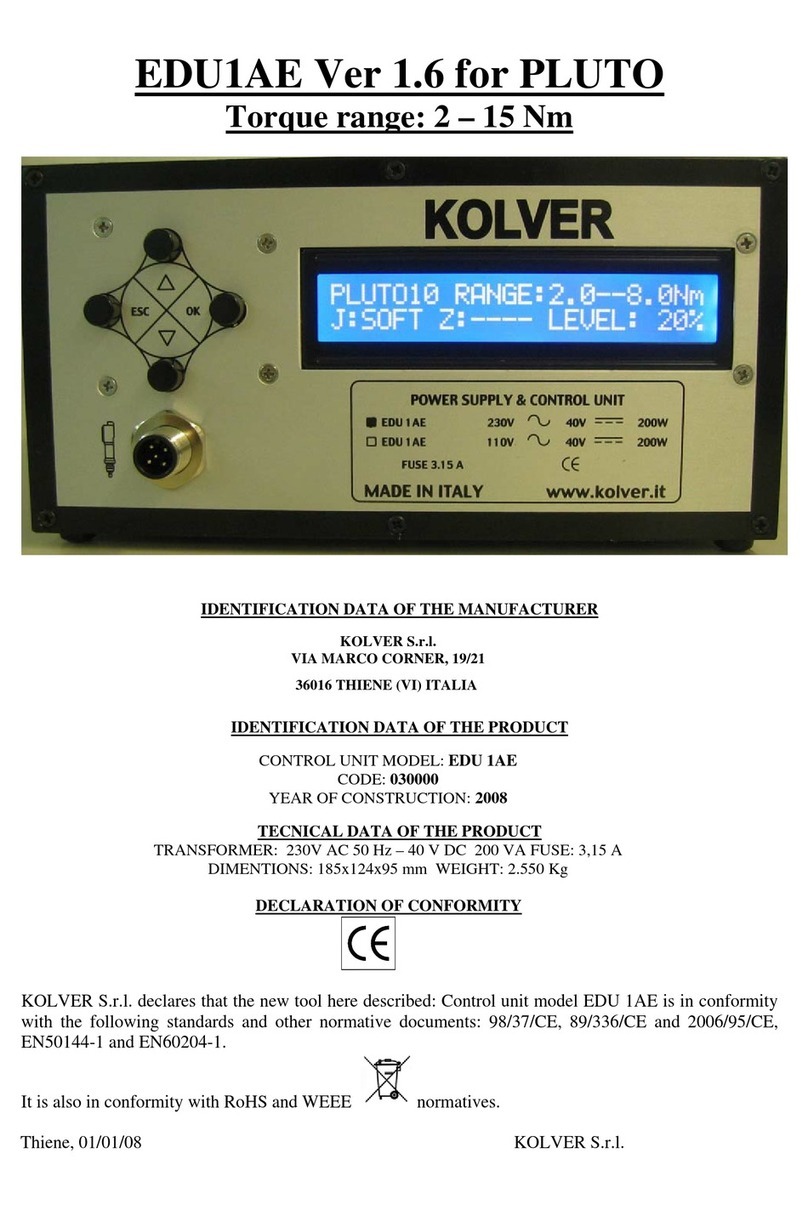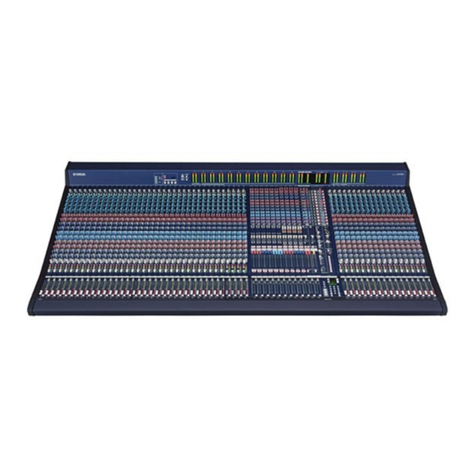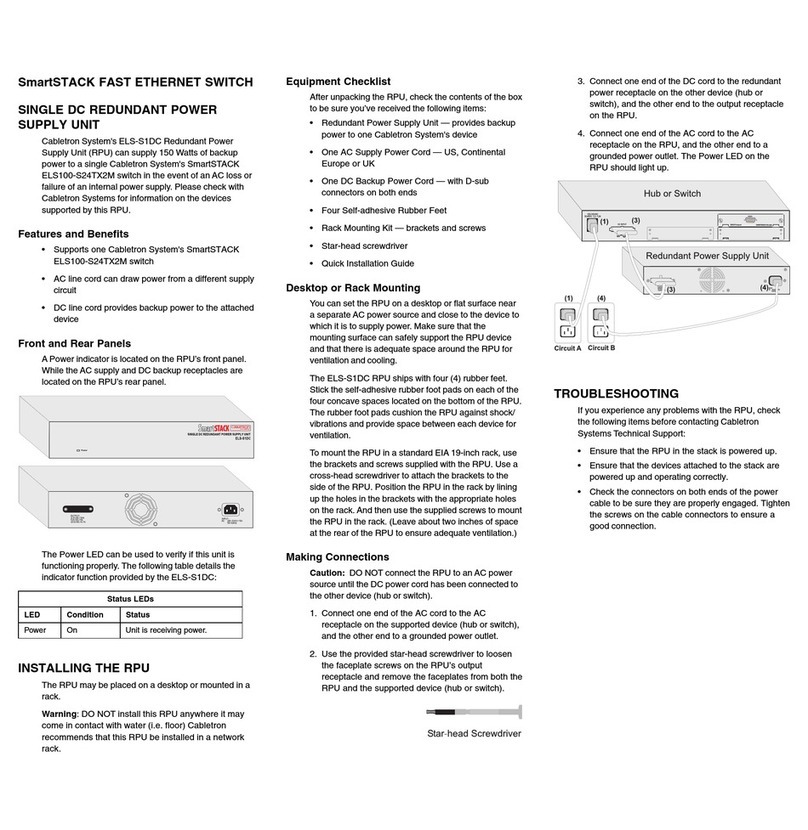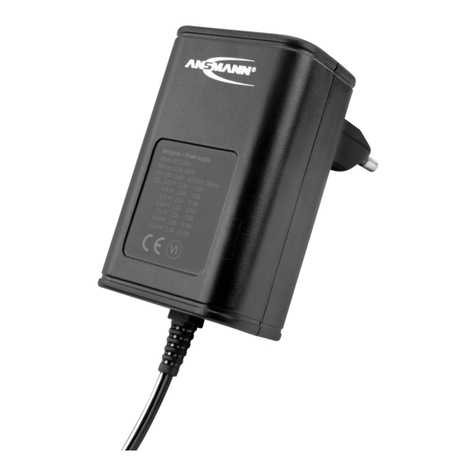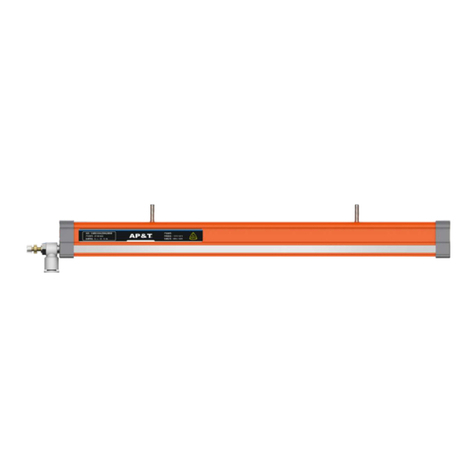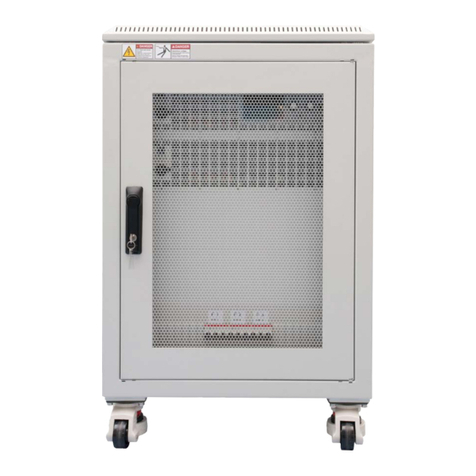CIOKS DC10 User manual

Type 2 –red with 5,5/2,1mm centre positive DC-plug x1
Type 4 –green with 5,5/2,5mm centre positive DC-plug x2
Type 5 –black with 3,5mm tip positive jack-plug x1
Type 6 –black with 9V battery clip x1
Split Flex type 1 –black with two 5,5/2,1mm centre negative DC-plugs x1
Stack Flex type 1 –black with 5,5/2,1mm centre negative DC-plug x1
Series Adapter Flex –2x white and 1x black RCA plugs x1
Mounting hardware
We’ve included all the needed hardware to mount the power supply on top or underneath a
Pedaltrain or Temple Audio pedalboard. You can of course also attach it to boards of other
brands. Look on CIOKS web site for more information and mounting guides.
Not included accessories
More Flex cables and Booster Flex
To power one pedal using one outlet you simply use a single suitable standard Flex cable and
that’s it. In case the plug type or length you need is not included with your unit there’s a big
selection of standard Flex cables to choose from and order them separately. In case of an odd
voltage or current requirement you might need one of the Special Flex cables available. Please
read more about these and how to use them on CIOKS web site or in the included Flex guide.
They really open up for even more versatility and flexibility in terms of what you can power
with your unit.
Powering different pedal types
This issue is different for every individual rig, therefore please e-mail your specific questions
Technical specifications
AC input: 110-120VAC 60Hz or 220-240VAC 50Hz, max. 35W
Outputs: Outlet 1-4: 9V DC / 100mA each, isolated
Outlet 5-6: 9 or 12V DC / 200mA each, isolated when not in Merge mode *
Outlet 7-8: 9 and 12V DC / 400mA, outlets 7 and 8 share the same GND
Outlet 9-10: 9 and 12 or 15V DC / 400mA, outlets 9 and 10 share the same GND
* can be merged into one 400mA section, where outlets 5 and 6 share the same GND
Size: 158x98x35mm (excl. rubber feet)
Weight: 1,1kg
Warranty period: 5 years worldwide
What’s in the box?
•CIOKS DC10 power supply
•mains power cord
•16 Flex cables
•pedalboard mounting HW (mounting bracket, screws, washers, stand-off and hex key)
•manual, product sheet (drill guide) and Flex guide
CIOKS DC10
Power Supply for Effect Pedals
User’s Manual
reversion 1.2 –March 2017
Introduction
Since 1991 the Danish company CIOKS has been providing guitar and bass players with
reliable power supplies dedicated for effect pedals. After our very first product CIOKS Baby
power supply was out in 1991, the Big John and Double Jack were launched in year 1995.
After a long break three more units were introduced in 2007 forming our Standard range of
dedicated power supplies for effect pedals. The big breakthrough came in year 2010 where
we’ve released the first products of the professional range with the DC10 as the most popular
product. CIOKS became global with distributors and dealers worldwide.
Features
•10 outlets configured in 8 isolated sections with a total current of 1.600mA
•3 powerful DC sections with 400mA each, able to power 3 high current pedals like
Strymon, Eventide or tc electronic Nova or Helicon pedals
•offers DC voltages 9, 12 and 15V and also 18 and 24V with Series adapter Flex
•15V option for a Radial Tonebone pedal or another Radial 15V unit
•toroidal transformer with additional magnetic field shielding
•short circuit protection of all outlets
•advanced LED monitoring of each isolated outlet or section
•compatible with Pedaltrain and Temple Audio pedalboards, mounting hardware incl.
Overview
Front
On the front of the enclosure you’ll find 10 outlets of the power supply as RCA sockets which
all are centre positive. Correct polarity for the pedal is achieved by using the right Flex cable.
Top
CIOKS logo in the middle has a red LED placed in the middle of the letter ‘O’. Right after the
power supply is turned on, it states your power supply’s serial number by blinking the digits.
Then it goes into the temperature depending ‘breathing mode’ or just stays turned on
depending on its setting.
On top of the enclosure you see the output voltage and max. current rating of each isolated
outlet or section printed just above the outlet sockets. The top figure is the voltage and the DC
in the middle line tells you it’s a direct current outlet. The bottom figure states the maximum
current capability of each outlet in mA. Outlets with two possible voltage settings have both
values stated e.g. 9/12 or 12/15. Isolated sections with two outlets sharing the same GND have
one common figure for maximum current which can be put out from both outlets in the section.

The status of each isolated output or section is shown by a LED indicator also situated on top
of the enclosure just above the voltage figure. The function of this advanced and unique
monitoring feature is described in detail later on.
Back
In the space on the back of the enclosure you’ll find the AC power input socket, mains voltage
selector switch, fuse and the settings switch.
The AC power input socket is called C6 according to the IEC 60320 standard and it’s the same
type used in many laptop power supplies.
Mains voltage selector switch should be used for setting the correct mains voltage 115 or
230V. The Japanese version is made only for a 100V nominal mains voltage and has no mains
voltage selector switch.
The fuse is the only part which can be replaced by the user. In case it’s blown, replace with a
5x20mm, T 500mA (slow blow/time lag) type.
The settings switch should be used for changing the operation settings of the power supply.
Bottom
Here you’ll find you’ll find a table showing the different settings of the power supply, which
you select using the settings switch on the back. Also here are the four detachable rubber feet
and 6 holes with metric M4 threads, which should be used for easy mounting of the power
supply to a pedalboard. Do not use screws, which would go further than 5mm inside the unit.
Have a look at the mounting guide on CIOKS web site.
Getting started
First make sure that the voltage value chosen on the voltage selector switch matches the mains
voltage in your wall socket. Connect the mains power cord to the power supply and mains wall
outlet. Using the right Flex cable types connect your pedals to the outlets of power supply
making sure that the voltage and current is correct for every pedal. Rock’n’Roll..! ...or JaZz!
Settings
To change the settings of the power supply you use the settings switch on the back of the
enclosure. In the table below you can see the different settings:
No.
Function
Switch OFF (down)
Switch ON (up)
1
LED mode
Breathing
Constant
2
Outlet 5+6
Isolated
Merged
3
Outlet 5
9V DC
12V DC
4
Outlet 6
9V DC
12V DC
5
Outlet 10
12V DC
15V DC
6
Not used
N/A
N/A
LED mode
The LED in the middle of letter ‘O’ in CIOKS logo can operate in either ‘breathing mode’ or
‘constant’ mode. You select the mode with switch knob no. 1.
Voltage settings
Voltage of outlets 5 and 6 can individually be set to 9 or 12V with switch knobs no. 3 and 4,
where the default value is 9V. Voltage of outlet 10 can be set to either 12 or 15V, where 12V is
default.
Isolated or merged operation of outlets 5 and 6
In the default setting outlets 5 and 6 operate as totally isolated outputs with a maximum current
of 200mA each. In case you need a third powerful 400mA section, you can merge these two
outlets by setting knob no. 2 to ON into a third 400mA section with two outlets sharing the
same GND. The voltage of these two outlets can still be set individually to either 9 or 12V.
The total current you draw from these two outlets should not exceed 400mA when added.
Features
Advanced LED Monitoring
Each isolated outlet or section has its individual LED status indicator. The indicator is lit in
normal operation. Its light gets dim when you operate just on the edge of the current limit. If
you overload or short circuit an outlet, the respective LED indicator turns off.
The LED indicators of outlets 5, 6 and 10 with selectable output voltages, also show you the
voltage chosen with the settings switch. In case a higher voltage than the default setting is
selected for a given outlet, its respective LED indicator will be lit with higher intensity than the
other indicators. Default setting for outlets 5 and 6 is 9V and for outlet 10 it’s 12V.
All indicators take into account the actual level of mains voltage when monitoring a possible
overload. The current limits for each outlet or section of the power supply are specified at
nominal level of the mains voltage. In Europe it’s 230V and 120V in e.g. United States. If the
mains voltage is higher than nominal, you can draw more current from the power supply than
stated in the specifications. This would never be a problem. A more common situation though,
is when the mains voltage is lower than nominal. In such a case maximum current ratings for
each outlet or section might be diminished.
The advanced LED monitoring of each isolated outlet will alert you in case of an overload or
short circuit. If such a situation happens you know where to look to solve the problem.
A glance at the LED status indicators and you have proof of 100% clean power to your pedals.
Breathing ‘O’ LED
The LED in the letter ‘O’ has two main functions. Just after the power supply is connected to
mains and starts to operate, the LED states the serial number of your unit by blinking each
digit if the number. Then depending on the setting it either starts to ‘breath’ or stays lit
showing that the power is on. The ‘breathing’ frequency is dependent on the temperature inside
the power supply and with higher temperature the ‘breathing’ gets more frequent.
Included accessories
Flex cables
CIOKS offers a great selection of different Flex cable types for connecting your pedals to the
power supply. Below you see a list of the included Flex cables with your unit:
Type 1 –black with 5,5/2,1mm centre negative DC-plug x8

The status of each isolated output or section is shown by a LED indicator also situated on top
of the enclosure just above the voltage figure. The function of this advanced and unique
monitoring feature is described in detail later on.
Back
In the space on the back of the enclosure you’ll find the AC power input socket, mains voltage
selector switch, fuse and the settings switch.
The AC power input socket is called C6 according to the IEC 60320 standard and it’s the same
type used in many laptop power supplies.
Mains voltage selector switch should be used for setting the correct mains voltage 115 or
230V. The Japanese version is made only for a 100V nominal mains voltage and has no mains
voltage selector switch.
The fuse is the only part which can be replaced by the user. In case it’s blown, replace with a
5x20mm, T 500mA (slow blow/time lag) type.
The settings switch should be used for changing the operation settings of the power supply.
Bottom
Here you’ll find you’ll find a table showing the different settings of the power supply, which
you select using the settings switch on the back. Also here are the four detachable rubber feet
and 6 holes with metric M4 threads, which should be used for easy mounting of the power
supply to a pedalboard. Do not use screws, which would go further than 5mm inside the unit.
Have a look at the mounting guide on CIOKS web site.
Getting started
First make sure that the voltage value chosen on the voltage selector switch matches the mains
voltage in your wall socket. Connect the mains power cord to the power supply and mains wall
outlet. Using the right Flex cable types connect your pedals to the outlets of power supply
making sure that the voltage and current is correct for every pedal. Rock’n’Roll..! ...or JaZz!
Settings
To change the settings of the power supply you use the settings switch on the back of the
enclosure. In the table below you can see the different settings:
No.
Function
Switch OFF (down)
Switch ON (up)
1
LED mode
Breathing
Constant
2
Outlet 5+6
Isolated
Merged
3
Outlet 5
9V DC
12V DC
4
Outlet 6
9V DC
12V DC
5
Outlet 10
12V DC
15V DC
6
Not used
N/A
N/A
LED mode
The LED in the middle of letter ‘O’ in CIOKS logo can operate in either ‘breathing mode’ or
‘constant’ mode. You select the mode with switch knob no. 1.
Voltage settings
Voltage of outlets 5 and 6 can individually be set to 9 or 12V with switch knobs no. 3 and 4,
where the default value is 9V. Voltage of outlet 10 can be set to either 12 or 15V, where 12V is
default.
Isolated or merged operation of outlets 5 and 6
In the default setting outlets 5 and 6 operate as totally isolated outputs with a maximum current
of 200mA each. In case you need a third powerful 400mA section, you can merge these two
outlets by setting knob no. 2 to ON into a third 400mA section with two outlets sharing the
same GND. The voltage of these two outlets can still be set individually to either 9 or 12V.
The total current you draw from these two outlets should not exceed 400mA when added.
Features
Advanced LED Monitoring
Each isolated outlet or section has its individual LED status indicator. The indicator is lit in
normal operation. Its light gets dim when you operate just on the edge of the current limit. If
you overload or short circuit an outlet, the respective LED indicator turns off.
The LED indicators of outlets 5, 6 and 10 with selectable output voltages, also show you the
voltage chosen with the settings switch. In case a higher voltage than the default setting is
selected for a given outlet, its respective LED indicator will be lit with higher intensity than the
other indicators. Default setting for outlets 5 and 6 is 9V and for outlet 10 it’s 12V.
All indicators take into account the actual level of mains voltage when monitoring a possible
overload. The current limits for each outlet or section of the power supply are specified at
nominal level of the mains voltage. In Europe it’s 230V and 120V in e.g. United States. If the
mains voltage is higher than nominal, you can draw more current from the power supply than
stated in the specifications. This would never be a problem. A more common situation though,
is when the mains voltage is lower than nominal. In such a case maximum current ratings for
each outlet or section might be diminished.
The advanced LED monitoring of each isolated outlet will alert you in case of an overload or
short circuit. If such a situation happens you know where to look to solve the problem.
A glance at the LED status indicators and you have proof of 100% clean power to your pedals.
Breathing ‘O’ LED
The LED in the letter ‘O’ has two main functions. Just after the power supply is connected to
mains and starts to operate, the LED states the serial number of your unit by blinking each
digit if the number. Then depending on the setting it either starts to ‘breath’ or stays lit
showing that the power is on. The ‘breathing’ frequency is dependent on the temperature inside
the power supply and with higher temperature the ‘breathing’ gets more frequent.
Included accessories
Flex cables
CIOKS offers a great selection of different Flex cable types for connecting your pedals to the
power supply. Below you see a list of the included Flex cables with your unit:
Type 1 –black with 5,5/2,1mm centre negative DC-plug x8

Type 2 –red with 5,5/2,1mm centre positive DC-plug x1
Type 4 –green with 5,5/2,5mm centre positive DC-plug x2
Type 5 –black with 3,5mm tip positive jack-plug x1
Type 6 –black with 9V battery clip x1
Split Flex type 1 –black with two 5,5/2,1mm centre negative DC-plugs x1
Stack Flex type 1 –black with 5,5/2,1mm centre negative DC-plug x1
Series Adapter Flex –2x white and 1x black RCA plugs x1
Mounting hardware
We’ve included all the needed hardware to mount the power supply on top or underneath a
Pedaltrain or Temple Audio pedalboard. You can of course also attach it to boards of other
brands. Look on CIOKS web site for more information and mounting guides.
Not included accessories
More Flex cables and Booster Flex
To power one pedal using one outlet you simply use a single suitable standard Flex cable and
that’s it. In case the plug type or length you need is not included with your unit there’s a big
selection of standard Flex cables to choose from and order them separately. In case of an odd
voltage or current requirement you might need one of the Special Flex cables available. Please
read more about these and how to use them on CIOKS web site or in the included Flex guide.
They really open up for even more versatility and flexibility in terms of what you can power
with your unit.
Powering different pedal types
This issue is different for every individual rig, therefore please e-mail your specific questions
Technical specifications
AC input: 110-120VAC 60Hz or 220-240VAC 50Hz, max. 35W
Outputs: Outlet 1-4: 9V DC / 100mA each, isolated
Outlet 5-6: 9 or 12V DC / 200mA each, isolated when not in Merge mode *
Outlet 7-8: 9 and 12V DC / 400mA, outlets 7 and 8 share the same GND
Outlet 9-10: 9 and 12 or 15V DC / 400mA, outlets 9 and 10 share the same GND
* can be merged into one 400mA section, where outlets 5 and 6 share the same GND
Size: 158x98x35mm (excl. rubber feet)
Weight: 1,1kg
Warranty period: 5 years worldwide
What’s in the box?
•CIOKS DC10 power supply
•mains power cord
•16 Flex cables
•pedalboard mounting HW (mounting bracket, screws, washers, stand-off and hex key)
•manual, product sheet (drill guide) and Flex guide
CIOKS DC10
Power Supply for Effect Pedals
User’s Manual
reversion 1.2 –March 2017
Introduction
Since 1991 the Danish company CIOKS has been providing guitar and bass players with
reliable power supplies dedicated for effect pedals. After our very first product CIOKS Baby
power supply was out in 1991, the Big John and Double Jack were launched in year 1995.
After a long break three more units were introduced in 2007 forming our Standard range of
dedicated power supplies for effect pedals. The big breakthrough came in year 2010 where
we’ve released the first products of the professional range with the DC10 as the most popular
product. CIOKS became global with distributors and dealers worldwide.
Features
•10 outlets configured in 8 isolated sections with a total current of 1.600mA
•3 powerful DC sections with 400mA each, able to power 3 high current pedals like
Strymon, Eventide or tc electronic Nova or Helicon pedals
•offers DC voltages 9, 12 and 15V and also 18 and 24V with Series adapter Flex
•15V option for a Radial Tonebone pedal or another Radial 15V unit
•toroidal transformer with additional magnetic field shielding
•short circuit protection of all outlets
•advanced LED monitoring of each isolated outlet or section
•compatible with Pedaltrain and Temple Audio pedalboards, mounting hardware incl.
Overview
Front
On the front of the enclosure you’ll find 10 outlets of the power supply as RCA sockets which
all are centre positive. Correct polarity for the pedal is achieved by using the right Flex cable.
Top
CIOKS logo in the middle has a red LED placed in the middle of the letter ‘O’. Right after the
power supply is turned on, it states your power supply’s serial number by blinking the digits.
Then it goes into the temperature depending ‘breathing mode’ or just stays turned on
depending on its setting.
On top of the enclosure you see the output voltage and max. current rating of each isolated
outlet or section printed just above the outlet sockets. The top figure is the voltage and the DC
in the middle line tells you it’s a direct current outlet. The bottom figure states the maximum
current capability of each outlet in mA. Outlets with two possible voltage settings have both
values stated e.g. 9/12 or 12/15. Isolated sections with two outlets sharing the same GND have
one common figure for maximum current which can be put out from both outlets in the section.
Other manuals for DC10
1
Table of contents
Other CIOKS Power Supply manuals

CIOKS
CIOKS Eventide PowerFactor 2 User manual
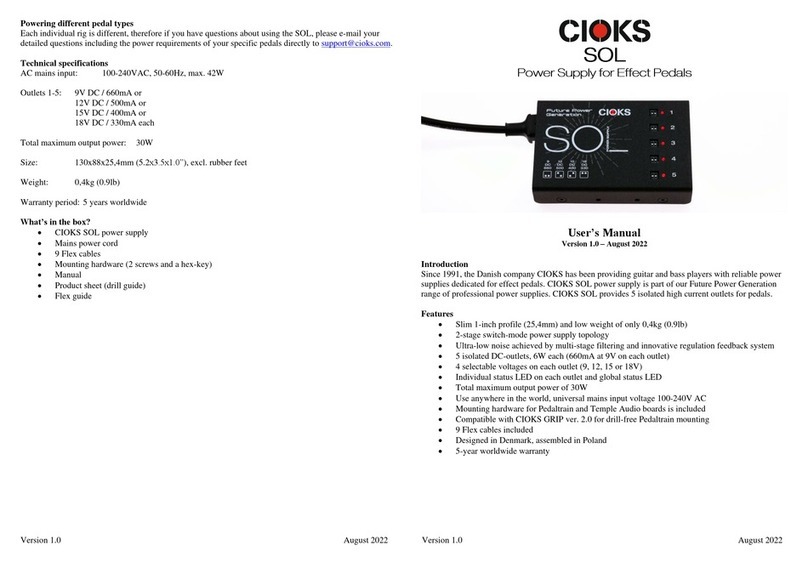
CIOKS
CIOKS SOL User manual
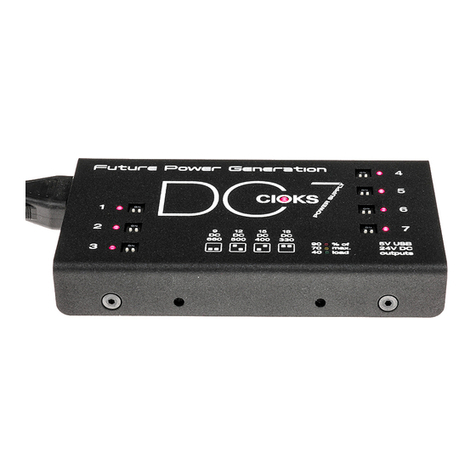
CIOKS
CIOKS DC7 User manual
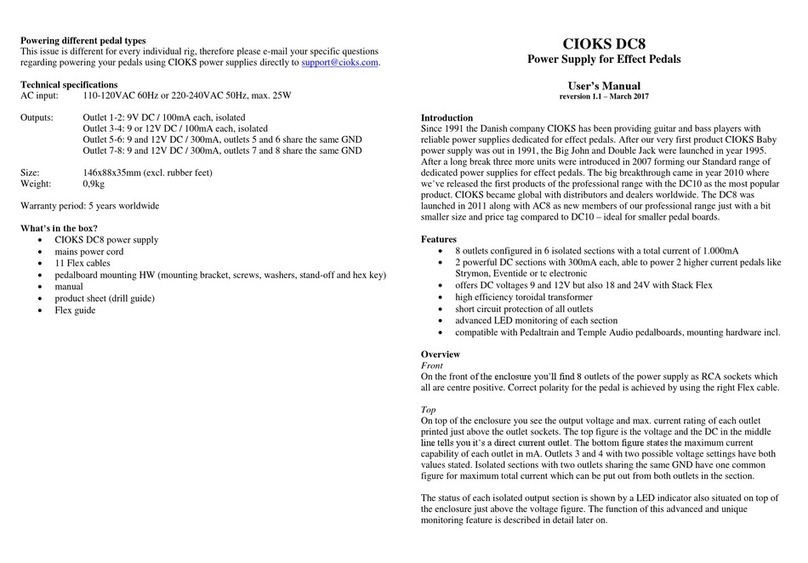
CIOKS
CIOKS DC8 User manual
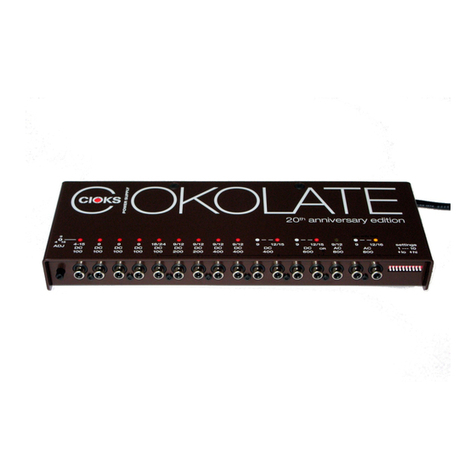
CIOKS
CIOKS CIOKOLATE User manual
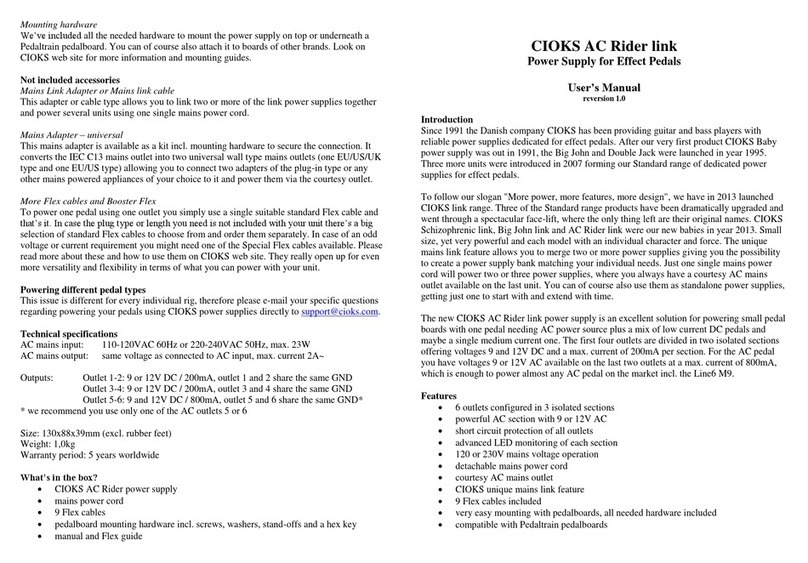
CIOKS
CIOKS AC Rider link User manual
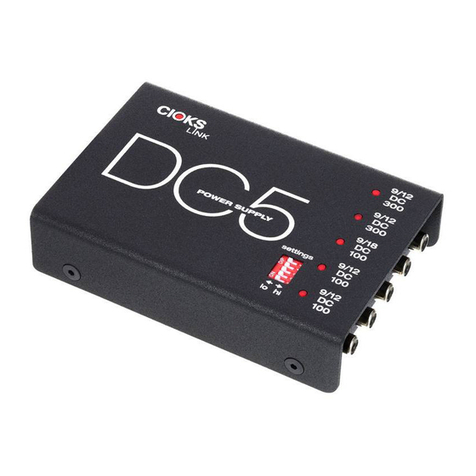
CIOKS
CIOKS DC5 User manual

CIOKS
CIOKS AC Rider link User manual
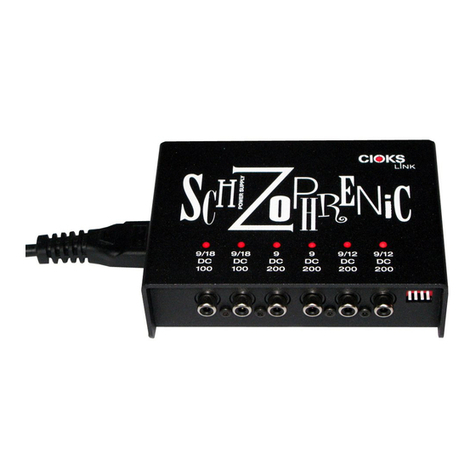
CIOKS
CIOKS LINK Series User manual
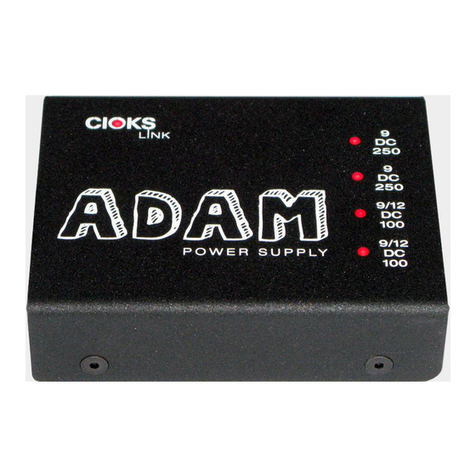
CIOKS
CIOKS Adam link User manual
